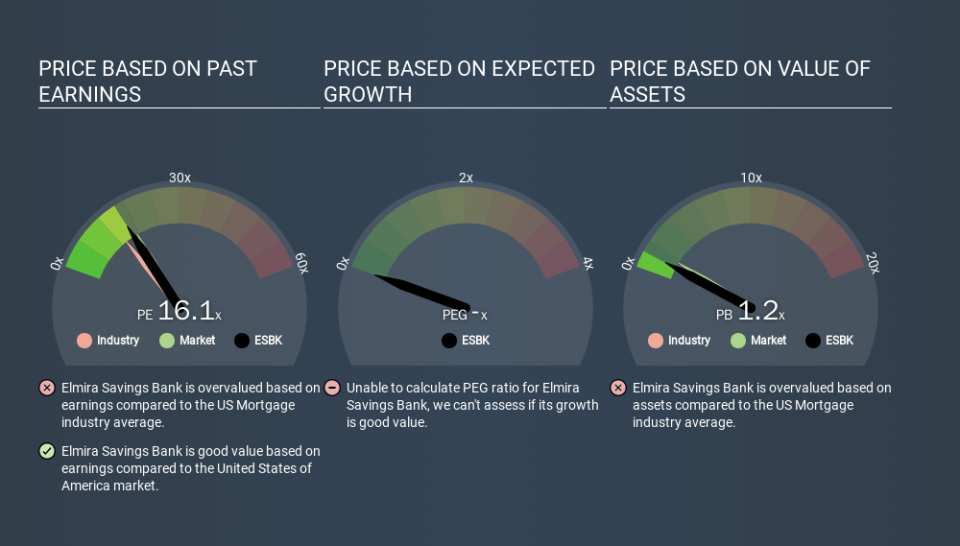Does Elmira Savings Bank's (NASDAQ:ESBK) P/E Ratio Signal A Buying Opportunity?

Elmira Savings Bank (NASDAQ:ESBK) shares have retraced a considerable in the last month. The recent drop has obliterated the annual return, with the share price now down 15% over that longer period. But shareholders who bought at the right time will be smiling, given that the stock is up 5.4% over the last quarter.
All else being equal, a sharp share price increase should make a stock less attractive to potential investors. While the market sentiment towards a stock is very changeable, in the long run, the share price will tend to move in the same direction as earnings per share. The implication here is that deep value investors might steer clear when expectations of a company are too high. Perhaps the simplest way to get a read on investors' expectations of a business is to look at its Price to Earnings Ratio (PE Ratio). Investors have optimistic expectations of companies with higher P/E ratios, compared to companies with lower P/E ratios.
See our latest analysis for Elmira Savings Bank
How Does Elmira Savings Bank's P/E Ratio Compare To Its Peers?
Elmira Savings Bank's P/E of 16.05 indicates some degree of optimism towards the stock. As you can see below, Elmira Savings Bank has a higher P/E than the average company (13.4) in the mortgage industry.
Elmira Savings Bank's P/E tells us that market participants think the company will perform better than its industry peers, going forward. The market is optimistic about the future, but that doesn't guarantee future growth. So further research is always essential. I often monitor director buying and selling.
How Growth Rates Impact P/E Ratios
When earnings fall, the 'E' decreases, over time. Therefore, even if you pay a low multiple of earnings now, that multiple will become higher in the future. Then, a higher P/E might scare off shareholders, pushing the share price down.
Elmira Savings Bank's earnings per share fell by 18% in the last twelve months. And over the longer term (3 years) earnings per share have decreased 6.0% annually. This might lead to low expectations.
Don't Forget: The P/E Does Not Account For Debt or Bank Deposits
Don't forget that the P/E ratio considers market capitalization. In other words, it does not consider any debt or cash that the company may have on the balance sheet. Theoretically, a business can improve its earnings (and produce a lower P/E in the future) by investing in growth. That means taking on debt (or spending its cash).
Such expenditure might be good or bad, in the long term, but the point here is that the balance sheet is not reflected by this ratio.
Elmira Savings Bank's Balance Sheet
Net debt is 30% of Elmira Savings Bank's market cap. You'd want to be aware of this fact, but it doesn't bother us.
The Verdict On Elmira Savings Bank's P/E Ratio
Elmira Savings Bank's P/E is 16.1 which is about average (17.1) in the US market. When you consider the lack of EPS growth last year (along with some debt), it seems the market is optimistic about the future for the business. What can be absolutely certain is that the market has become less optimistic about Elmira Savings Bank over the last month, with the P/E ratio falling from 16.1 back then to 16.1 today. For those who prefer to invest with the flow of momentum, that might be a bad sign, but for a contrarian, it may signal opportunity.
Investors should be looking to buy stocks that the market is wrong about. If it is underestimating a company, investors can make money by buying and holding the shares until the market corrects itself. Although we don't have analyst forecasts shareholders might want to examine this detailed historical graph of earnings, revenue and cash flow.
But note: Elmira Savings Bank may not be the best stock to buy. So take a peek at this free list of interesting companies with strong recent earnings growth (and a P/E ratio below 20).
If you spot an error that warrants correction, please contact the editor at editorial-team@simplywallst.com. This article by Simply Wall St is general in nature. It does not constitute a recommendation to buy or sell any stock, and does not take account of your objectives, or your financial situation. Simply Wall St has no position in the stocks mentioned.
We aim to bring you long-term focused research analysis driven by fundamental data. Note that our analysis may not factor in the latest price-sensitive company announcements or qualitative material. Thank you for reading.

